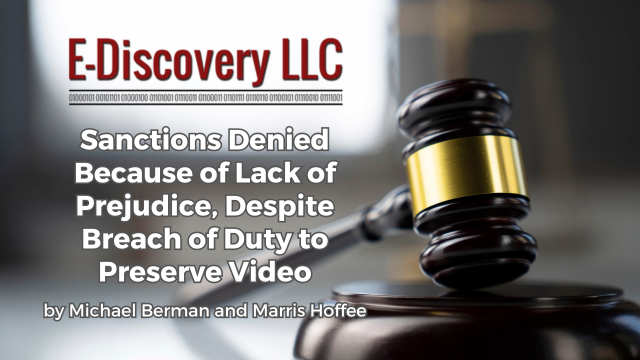
[EDRM Editor’s Note: The opinions and positions are those of Michael Berman and Marris Hoffee.]
In Moore v. Wash. Metro. Area Transit Auth., 2025 WL 1374125 (D. Md. May 30, 2025), the District of Maryland applied a three-part test for imposing spoliation sanctions.
Ms. Moore alleged that she was injured when the wheelchair lift of a MetroAccess van suddenly jolted, causing her to fall. Although she did not see what the lift operator did, she believed that he did not operate the lift properly.
The Washington Metro Transit Authority (“WMATA”) denied the allegation. WMATA’s MetroAccess van was equipped with a “Drive Cam” that captures real-time video; however, footage of the incident was neither downloaded nor preserved.
WMATA moved for summary judgment based on the lack of expert testimony. In response, Ms. Moore sought spoliation sanctions, asserting that WMATA failed to preserve the Drive Cam video of the occurrence.
The Court found that WMATA breached its duty to preserve the footage; however, it denied sanctions, holding that Ms. Moore failed to demonstrate the requisite relevance and prejudice.
Here, WMATA reasonably should have known that the video footage may be relevant to anticipated litigation as a result of Moore’s fall and injury while on the wheelchair lift, and a duty to preserve the footage attached.
Moore v. Wash. Metro. Area Transit Auth., 2025 WL 1374125 (D. Md. May 30, 2025).
The Court applied a three-part test for imposing spoliation sanctions. Id. at *3.
First, the moving party must establish that there was a duty to preserve potentially relevant evidence. That duty arises “when a party reasonably should know that the evidence may be relevant to anticipated litigation.” Id. at *3 (quotations and citations omitted). The Moore Court held that WMATA’s duty arose at the time of Ms. Moore’s injuries. The fact of the injury was held sufficient to trigger that duty. The Court wrote:
Here, WMATA reasonably should have known that the video footage may be relevant to anticipated litigation as a result of Moore’s fall and injury while on the wheelchair lift, and a duty to preserve the footage attached. A prudent person acting under like circumstances would have saved and downloaded the Drive Cam footage from the MetroAccess van in anticipation of future litigation.
Id. at *4.
Second, to meet the culpable state of mind requirement, the party seeking sanctions must show that the spoliating party acted negligently, willfully, or in bad faith. Id. at *4. Ordinary negligence is a failure to preserve evidence “where a reasonably prudent person acting under like circumstances would have done so.” Willfulness is “deliberate conduct resulting in spoliation.” Bad faith requires that evidence be destroyed “for the purpose of depriving the adversary of evidence.” Id. Ms. Moore’s allegations of negligence were sufficient to satisfy this element of the spoliation doctrine.
Third, relevance in the spoliation context is more stringent than relevance under Fed.R.Evid. 401. Evidence is considered relevant for the purposes of spoliation if “a reasonable trier of fact could conclude that the lost evidence would have supported the claims or defenses of the party that sought it.” Id. This requires a two-prong analysis. There must be both: (1) relevance; and, (2) prejudice. Prejudice exists only “where the party’s ability to present its case is compromised as a result of the missing evidence.” Id.
Although the Fourth Circuit permits a rebuttable presumption of relevance where willfulness or bad faith is shown, Ms. Moore made no such showing. The Court observed: “Moore provided no evidence that WMATA acted with any greater culpability than ordinary negligence.” Therefore, she was required to show “a reasonable possibility, based on concrete evidence rather than fertile imagination, that access to the lost material would have produced evidence favorable to [her] cause.” Id.
Applying these principles, the Moore Court held that Ms. Moore failed to establish the third element. Although Ms. Moore claimed the missing video was objective evidence that “could corroborate or refute” the parties’ testimony, she offered no particularized evidence that the footage would have supported her claim. It appears that she could not offer such evidence because she did not see the controls that were being operated. Furthermore, even if she had shown that the footage had been favorable, the Court held that it would not have cured her failure to establish the applicable standard of care through expert testimony.
Although the duty to preserve had been breached, the Court declined to impose sanctions because Ms. Moore did not meet her burden of demonstrating relevance under the two-prong test. Id. at *4.
Although Ms. Moore claimed the missing video was objective evidence that “could corroborate or refute” the parties’ testimony, she offered no particularized evidence that the footage would have supported her claim.
Michael Berman, E-Discovery LLC, and Marris Hoffee, Keilty Bonadio.
It is interesting to observe that the Court did not apply the ESI sanctions rule, Fed.R.Civ.P. 37(e), to the missing video. That Rule applies when ESI that should have been preserved is lost due to a party’s failure to take reasonable steps to preserve it. In our view, the result would likely have been the same under Rule 37(e).
However, where Rule 37(e) applies, it provides the exclusive remedy for ESI-related spoliation. Bistrian v. Levi, 448 F. Supp. 3d 454, 464 (E.D. Pa. 2020). In Bistrian, one litigant argued “that the video footage does not qualify as ESI.” The government responded that the cameras “were digital, so the footage was ESI.” The court found Rule 37(e) applied, writing: “While there is no definitive evidence as to whether the FDC’s surveillance footage was digital or analog in 2006, it appears almost certain that it was digital, so Rule 37(e) applies.”
In Gerges v. LGA 2020 JV LLC, 2025 WL 1272922, at *2 n. 1 (E.D.N.Y. Feb. 28, 2025), the court wrote: “Neither party appears to dispute that the footage is electronically stored information.” In Bergeron-Davila v. King, 2025 WL 561062, at *3 (E.D. Wis. Feb. 20, 2025), the court stated that: “If the video has not been preserved, the plaintiff may seek relief under Federal Rule of Civil Procedure 37(e).” Another held that: “The spoliation of video footage and other electronically stored information is governed by Federal Rule of Civil Procedure 37(e)….” Collins v. Davis, 2024 WL 5011645, at *1 (W.D. Va. Dec. 6, 2024), citing Wall v. Rasnick, 42 F.4th 214, 222–23 (4th Cir. 2022).
Assisted by GAI and LLM Technologies per EDRM GAI and LLM Policy.



